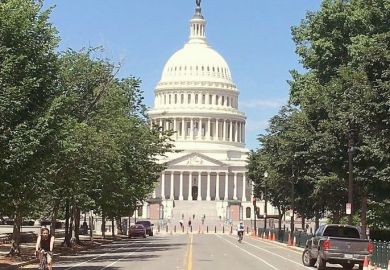US President Joe Biden is planning another shot at free tuition for the nation’s most needy institutions, while largely relenting to Republican demands for a retrenchment in research spending.
As part of his $7.3 trillion (£5.7 trillion) US government budget outline for the 2025 fiscal year, Mr Biden promised to try again for a federal-state partnership that would eliminate two years of fees for lower-income students at community colleges and minority-serving four-year campuses.
The plan also would hike the maximum value of a Pell Grant – the federal government’s main student subsidy – from $7,395 to $8,145, among several efforts to help students pay less and graduate more.
But on the research side, Mr Biden paid much closer attention to the budget deal he accepted last year, in which he avoided a government shutdown by accepting a Republican demand for spending caps for fiscal years 2024 and 2025. Mr Biden asked Congress for slightly more than $200 billion in research spending for fiscal year 2025, up just 1 per cent from last year’s level.
The president issued the 2025 spending plan while still waiting for Congress to finish budget bills for the current fiscal year, which began back in October.
Congress did, however, just approve a bipartisan agreement on several elements of the 2024 budget, including research, where several key funding agencies took cuts, including an 8 per cent spending reduction for the National Science Foundation.
The Biden plan would give the NSF about $10 billion next year, a major jump from its new current level of about $9 billion, but barely above its 2023 level. The president proposed giving the National Institutes of Health nearly $48 billion, up 2 per cent from last year’s figure.
Such anaemic funding levels pose a major risk for the US, the Association of Public Land-grant Universities said in response to the Biden plan.
“The US continues to lead the world in innovative sectors such as artificial intelligence, biotechnology and advanced energy technology,” said the APLU’s president, Mark Becker, a former president of Georgia State University. “But that leadership is not a birthright. It requires sustained robust investment in our future.”
Yet in its election-year budget blueprint, the Biden administration appeared driven more heavily by the political value of increasing aid for students and their families through expanded Department of Education resources. In that regard, the Biden budget plan “blows the Trump budgets out of the water”, the US secretary of education, Miguel Cardona, said in a briefing with reporters to outline the plan.
Less clear, though, was whether it would have much success. In his 2020 presidential campaign, Mr Biden promised a free-college initiative aimed at community colleges, funded jointly by federal and state money, with repeated attempts since then. It nevertheless has been stymied by opposition from congressional Republicans and a lack of eagerness among four-year institutions to direct that much federal help toward their two-year counterparts.
While several states have created their own free-college programmes, the pathway to success on a national level does not appear to have eased. Mr Biden last year accepted the overall spending caps for 2024 and 2025, and the Republican chair of the Committee on Education and the Workforce in the US House of Representatives, Virginia Foxx, responded to the department’s fiscal 2025 budget plan by calling it a recipe for “more unsustainable and irresponsible debt”.
Ms Foxx specifically rejected the ideas of creating free community colleges and significantly increasing in the Pell Grant, “with no accountability to ensure the degrees students are given actually yield high-quality jobs”.
Mr Biden has found more success with his 2020 campaign promise to forgive accumulated student loan debt, as Congress long ago gave presidents broad discretion in that realm. The US Supreme Court last year blocked Mr Biden’s attempt at an across-the-board order of debt forgiveness – a $400 billion bid to wipe away $20,000 apiece for nearly all borrowers. But in a series of smaller targeted actions – mainly involving for-profit institutions found to have misled their students about their job prospects – the president has so far eliminated about $138 billion in student debt for nearly four million borrowers.
The Biden budget plan overall seeks $82 billion for the US Department of Education, up 4 per cent from current levels. The department said its elements included $2.7 billion for student loan borrowers, an increase of 31 per cent; $262 million for “strategies to improve post-secondary attainment, degree completion and student success”, a 42 per cent increase; and $93 million to help community colleges and minority-serving institutions, an increase of more than 8 per cent.
The leading US higher education lobby group, the American Council on Education, praised the overall package. “While the president’s budget proposal for Pell Grants requires additional analysis, his commitment to making progress toward doubling the maximum award is one we strongly support,” said Jonathan Fansmith, ACE’s senior vice-president for government relations.
Register to continue
Why register?
- Registration is free and only takes a moment
- Once registered, you can read 3 articles a month
- Sign up for our newsletter
Subscribe
Or subscribe for unlimited access to:
- Unlimited access to news, views, insights & reviews
- Digital editions
- Digital access to THE’s university and college rankings analysis
Already registered or a current subscriber?








